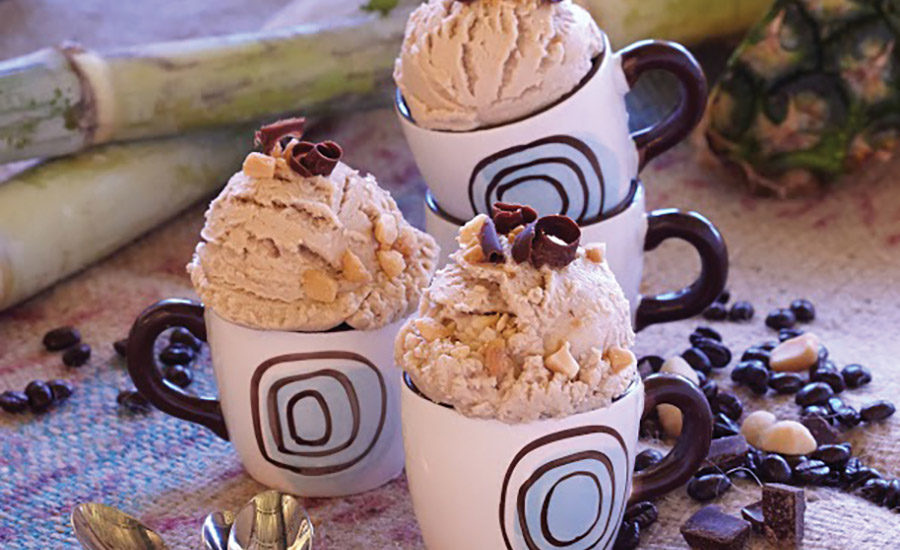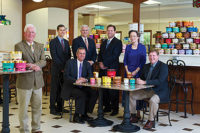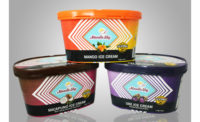Tropical topics
Magnolia ice cream blossoms with tropical flavors
Moving from a grocer’s ethnic door to the ice cream door is where the company wants to be. But, as an executive notes, “It’s a lot more crowded in the ice cream door.”

The third generation of the Quesada family (from left, PJ, Susie and Ronald) are taking Filipino flavors to mainstream America. Photo courtesy of Vito Palmisano

Ramar Foods is named for Ramon and Maria Quesada, the founders. Their son Primo and his wife Evangeline (above) developed and expanded the company, as the Asian immigrant population grew in the United States. Their children, (from left) Susie, Ronald and PJ, run the company today. Photo courtesy of the Quesada family

To emphasize the tropical flavors, Ramar Foods redesigned the packaging for its Magnolia brand of ice cream and stick novelties. The company is securing placement in the ice cream doors of mainstream grocers, rather than in their ethnic doors. Photo courtesy of Ramar Foods

Newly opened stores in Honolulu (pictured) and Las Vegas helps Ramar Foods with retail sales of its Magnolia ice cream. Photo courtesy of Ramar Foods

Magnolia’s Kona coffee-flavored ice cream with macadamia nuts and chocolate appeals to the less-adventurous mainstream U.S. consumer, who might balk at the company’s popular Asian flavors, like lychee or ube. Photo courtesy of Ramar Foods





Is mainstream America ready for purple yam ice cream? The trends are favorable. Food and flavor preferences are moving in the direction of adventurous eating. Fusion cuisines keep evolving as the nation becomes increasingly multicultural.
The owners of Ramar Foods are counting on the day when most Americans don’t bat an eye at scooping such popular Filipino ice cream flavors as purple yam (or ube, pronounced ooh-beh), avocado and lychee. In the meantime, the owners are happily watching sales increase for more recognizable flavors like coconut, chocolate and mango.
The Pittsburg, Calif.-based firm is more than an ice cream processor. It makes frozen foods like pancit (a noodle dish), highly seasoned chicken adobo and lumpia (a kind of egg roll) that are popular in Asian communities.
Ramar’s ice cream brand, Magnolia, has grown beyond mom-and-pop ethnic grocery stores to large chain supermarkets and into the home freezers of consumers across the United States.
CEO Susie Quesada explained the origins of mixing avocados with dairy.
“My dad used to take avocados, mash them with milk, and then add sugar and mix it around so it was a chunky shake,” said Quesada, the oldest of the three children of Primo and Evangeline Quesada. “He wouldn’t put it in a blender or anything. That’s how we ate avocados growing up,” Susie said. The reaction of their non-Filipino guests was “That’s kind of an odd thing,” she recalled. Then Primo took the shake concept and turned it into ice cream.
But until avocado and the best-selling ube flavors catch on, the Quesadas (Susie and her brothers Ronald and PJ) will put the emphasis on more familiar flavors like coconut, mango and coffee-chocolate-macadamia nut. These gateway flavors will introduce what she calls “mainstream” shoppers to the Magnolia brand.
The retail business
Primo and Evangeline Quesada grew sales of Ramar Foods in tandem with the growth of the Asian population in the United States. The 2010 U.S. Census reported that 5.6% of the population was Asian, either alone or in combination with one or more races. The Asian population grew 45.6% from 2000 to 2010.to 17.3 million. The Filipino population increased 44.5% to 3.4 million. It is the second-largest Asian group, after Chinese (4 million).
“We built the company selling to small, independent Asian stores where they just sell Asian groceries,” said Ronald, who is involved in marketing and creative services.
He described the evolution of the Asian shopper who moved from Asian grocers to large chains for general merchandise but continued to shop at Asian groceries for the specific fish, produce and dessert items that the big stores don’t carry.
“There are now Asian markets that are trying to be a one-stop shop. So it’s like a supermarket format. You’ll even have non-Asians shopping there because the location is better but they can still get what they need. They also offer the more exotic stuff like our ice cream,” Quesada said. “I call them medium-chain groceries. These are the stores like Seafood City, Island Pacific and 99 Ranch.”
“We sold enough ice cream tubs in 2014 to make me think that every Filipino had us in their freezer at least once during the year. But I think there is going to be a limit to how much more we can grow by just targeting Filipinos,” he said.
That’s the reason Ramar Foods now is going into mainstream supermarkets, including Whole Foods, Ralph’s (Kroger’s division in California) and H-E-B stores in Texas. PJ Quesada called the northeast, New Jersey and New York “a nice little area for us.” Kings Supermarkets in New Jersey and Morton Williams stores in Manhattan carry the brand.
As Ramar pursues the mainstream, the chains have recognized interest in ethnic offerings.
“They’re also interested in offering ethnic aisles in the grocery or even in their freezer space. So they have a Hispanic section, Asian section. Some stores, especially the ones in really diverse neighborhoods, they’re giving us doors in their freezer for our products. We’re really excited about that,” Quesada said.
Courting the large chains meant reframing what Magnolia was all about. Conversations with brokers and retailers used to start with: “These are Asian ice cream flavors.”
“What we would say to retailers is, ‘This is the No. 1 ice cream brand in the Asian demographic space.’ And that’s something we thought they would find valuable. And they did, to a point. But once we realized we were positioning it as an Asian ice cream, they weren’t really sure what to do with it, where to merchandise it, etc. So we shifted to talk about it as being tropical, because the Philippines is a very tropical country. When we started talking about it in a tropical sense, it started to make sense to the buyers and also to the consuming public. The potential market size started to really develop. We’re still in the early phases of that,” he said.
Moving from a grocer’s ethnic door to the ice cream door is where the company wants to be. But, as PJ noted, “It’s a lot more crowded in the ice cream door.”
Management also realized it needed a new package design if it were to compete with mainstream ice cream brands. The new designs make references to surfing and the beach. A package of lychee ice cream notes that it is “as refreshing as a killer curl but a lot creamier.” The coconut flavor is “so intense you’ll feel like one dropped on your head.”
Besides Magnolia, Ramar Foods has another brand called Primo Sorbetero, named for Primo Quesada. This line of ice creams and sorbets is made and currently sold in Europe, with other countries in the works.
Management and leadership
All of the Quesada siblings grew up in the plant. Susie, Ronald and PJ made bulk cans, applied labels to cartons and scooped ice cream at festivals and at in-store demonstrations. None intended to make food processing a career.
Susie studied multicultural literature at the University of California and then earned teaching credentials at Saint Mary’s in Moraga, Calif. She taught middle school for about six years before her father asked her to join the company full-time. When she hesitated, he told her, “You don’t lose tenure in two years, so you can go back to teaching.”
Ronald majored in music at San Francisco State University and then managed the company’s real estate interests while pursuing a career in music. PJ graduated from John F. Kennedy in Berkeley, then co-founded a video production studio.
Susie said that when she joined the company (starting in marketing), “I learned about all the hard work and the legacy of what my parents and grandparents had started. I really wanted to be a part of it. To see the [employees] and to know that their family’s livelihood was based on the company doing better, I knew that I could make a difference. Getting into public education, it’s all about making a difference. I could see that I could also make a difference in the business world, just in a different way.”
She is continuing her education this year at Harvard Business School in a three-year-long program for business owners and entrepreneurs. She will be at the university for three weeks every year.
Primo and Evangeline Quesada were born in the Philippines but their children were born in California. PJ talked about his cultural identity as a Fil-Am (Filipino-American) and the role it plays at Ramar Foods.
“I think it’s one of our main drivers. We identify as Filipino but we were born in the United States. So we have kind of one foot in a more traditional culture with very strong family values, always honoring your elders. But then we have this other foot in the new American Millennial model of staunch individualism, consumerism and lifestyle experience,” he said.
Susie Quesada is active in the Filipino community in the Bay Area. The Filipina Women’s Network honored her as one of nine Keepers of the Flame to ensure that its long-range mission is kept alive: a Filipina woman leader in every sector of the global economy.
One day Susie called PJ, who was still working at his production company, to make some television commercials for Ramar.
“I had so much fun doing it, I realized that the story I was telling was partly my story,” he said. “And that’s really where it became a much more personal thing for me. In late 2007, I decided to leave the business that I co-founded and come in here.”
PJ started in the marketing department doing graphic design.
“[I saw my parents] put all of their life into this company, and I’m honored to be able to be there. A lot of these people out in the office, they’ve known me since I was a baby and now I’m working with them in a capacity where they’re following our strategic direction. I never would have been able to predict that, definitely not.”
Working in a family business produces good times and tough times, as in any business and in any family, PJ said. But that is no surprise. He wrote his college capstone thesis about family business succession planning and learned about the dynamics of family businesses.
“I think we’re extremely fortunate to be working with our family. We argue about the right stuff and we trust each other. We all have amazing ideas that don’t always work together,” he said. “It does complicate things with the work/life balance, especially when your dad is your boss. Sometimes you get a phone call from him. You’re not sure if he’s asking about Thanksgiving dinner or an email that might have just come through.”
Deconstructing food
“My dad comes from a long line of entrepreneurs,” said Susie Quesada. “My grandmother actually started the company in ‘69,” with her husband, Ramon. Ramar is a portmanteau word from the founders’ names: Ramon and Maria.
“She was just a serial entrepreneur. She had a food truck in the Philippines, a bowling alley and a restaurant. She was one of the first food truck pioneers before they even became popular. When they came here, she started importing the food,” Susie said.
Her parents, Primo and Evangeline, love food and experimented with recipes.
“My mom got a degree in hotel and restaurant management. When we would go to restaurants we’d be like, ‘Oh, we can make this.’ My mom would pick out all the ingredients and recreate it so we wouldn’t have to go to the restaurants anymore. We’ve always been surrounded by the love of food. All of us, my brothers, we love to cook and love to eat.”
The third generation of Quesadas found a new ice cream flavor in a Vietnamese restaurant, where PJ was eating with his future father-in-law.
“We were all eating our Thai iced tea with the little tapioca pearls, and he said, ‘You know, this would be a really great ice cream flavor,’” PJ recalled.
He bought four Thai iced teas, gave them to Ramar’s R&D team and asked them to develop a new ice cream flavor.
“It was actually pretty challenging to create that flavor,” Quesada said. “We learned that a lot of the Thai tea flavoring out there is powdered. It’s got some artificial stuff in there. So we went straight to the source. We bring in the tea bulk and we brew it in our pasteurization tanks. That’s probably one of our most popular flavors among the Millennial generation.”
Marketing and advertising
Ramar Foods exhibits the Magnolia brand at trade shows. It does well at the annual Fancy Food Show in San Francisco. The brand succeeds because of the unique flavors, the premium quality and its clean label, PJ said.
Magnolia is priced at the premium end. A 1.5-quart package retails from $7 to as much as $10. Pints are usually $4 to $5. Even at that price, sales of specialty brands, like Magnolia, are growing while those from the large CPGs are flat, he said.
The advertising choices depend upon the consumer market.
“There’s the Asian immigrant market, and they have very specific media choices that they use throughout the day,” PJ said. “These would be like subscriber-only, native-language television channels and some radio. On the ethnic side, that’s primarily where our dollars go. On the general market, because we’re still just kind of getting started, most of our investment is really in public relations and social media.”
The ethnic ads are produced in Tagalog (the Filipino language) and in English.
“It depends on a variety of factors, which one will air and when. Online, we typically make both of them available. Our generation, the Fil-Ams, most of us do not speak Tagalog. And I think that’s because the Asian immigrants arrived in this country already speaking fluent English, so assimilating was easier in some senses. There is a lot of emphasis on integrating,” PJ said.
Growing pains, challenges
The California drought is affecting all dairy processors in the state. One consequence is that milk prices are higher. Susie is prepared to deal with it.
“Costs are just always going up. Shrinking margins are definitely something we’re keeping our eye on. We’re looking for more efficiencies in our normal expenses and in our production. That’s something that we’re honing in on,” she said.
Another challenge is educating mainstream America about Filipino ingredients and flavors.
“We’re used to people expecting the flavors that they would get in the Philippines,” Ronald said. “Now, when we are looking at new markets we really have to start from ground zero, figure out from an outsider perspective what people are going to be interested in. By positioning it as a tropical ice cream, we’re trying to reduce the learning curve.”
The mainstream shopper has accepted coconut, “but we are not the only coconut ice cream on the market. The avocado and Thai tea, that lets us stand out. We’re finding a lot of success with this kind of thing in those markets,” he said.
The Asian supermarket sector is informal, PJ said. A sales person can walk in, talk to the buyer and Ramar can have one of its new products on the shelf the next day. Not so with larger customers.
“You get the appointment during the category review. Once you’re approved, in six to eight months you’ll be on the shelf,” he said, adding that there are challenges in the supply chain, obtaining certifications on certain ingredients and new promotional models to learn.
“We’re in one division of Kroger right now, and that’s only about 80 stores,” PJ said. “But if Kroger were to call us and say ‘We’re putting you in every one of our divisions,’ that’s 2,400 stores. That’s an awesome problem to have but there are a lot of steps that we would need to take to be able to serve that type of customer.”
Ramar Foods is developing systems and procedures to enable it to grow.
“We have to look at every aspect of the company to make sure that we can serve those customers moving forward,” he said. “We’ve learned a ton in the last few years. We’ve already started working with UNFI and C & S Wholesale Grocers. These customers really challenged our initial assumptions of the old way of just ‘make the best product possible and just get it out there.’” It’s gotten a lot more complicated,” Quesada said.
Looking forward
Besides expanding beyond Asian supermarkets, Ramar is seeking growth in restaurants. The Quesadas believe there is a place on a restaurant menu for some of its exotic flavors.
“For the restaurants and the chefs that want to bring a complete end-to-end unique experience, why not throw avocado ice cream in there? Why not throw lychee ice cream in there? In all aspects of our business, not just in ice cream, foodservice is a really attractive category focus,” PJ said.
Ramar also sells ice cream mix to operators in the Bay Area. Its biggest initiative, though, is the opening of two scoop shops last year in Honolulu and Las Vegas. These projects are spearheaded by the Quesadas’ parents, who have involved themselves with store openings and events. They are “working at retirement,” Susie said of her parents.
“I think [the shops] will be great for our brand because people can actually go and interact with the brand in person,” Susie said. “Our whole idea is to have a really great brand experience. People [will] see that Magnolia is a high-quality but fun company where you can go with your family and enjoy dessert. It will really complement the business that we do now because instead of just seeing us on the shelf there’s going to be a face and a name to that.”
Retail sales of the ice cream at a nearby grocery increased after the Honolulu scoop shop opened, Ronald said, pointing out how one channel supports the other.
Community outreach
As Ramar Foods expands to reach mainstream America, it remains close to its roots. Primo and Evangeline Quesada established a college scholarship program for students in the United States and the Philippines. The U.S. scholarship is for employees and their children. The Philippines scholarship is awarded to children who have a socioeconomic need.
Susie said she intends to continue the legacy of her grandmother and parents, which is making high-quality products.
“That’s why our ice cream is premium. We use 14% butterfat because we want all our products to taste good and to be good for the community. Good ingredients sustain the health of the community. Food always brings us together. It’s one of those things no matter what, when you’re trying to learn about a new culture, you learn about their food first. That’s this doorway into learning about the history,” she said.
A mural on the outside of the Ramar Foods headquarters building tells the story of immigration, said Ronald. It shows a family gathered around a table set with food.
“That’s how we think of the business. The family is the center of our lives, and at the center of that family is a table full of food. You really can get to know people through the food,” Ronald said.
Looking for a reprint of this article?
From high-res PDFs to custom plaques, order your copy today!











